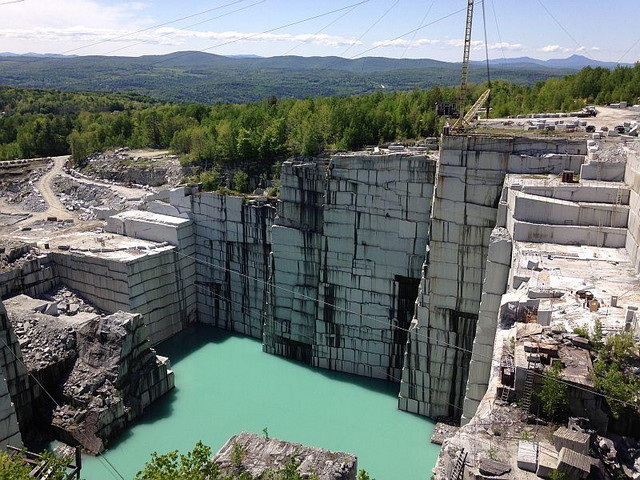Digging In To The History Of Rock Of Ages
Rock of Ages is the grand name of one of Vermont’s oldest quarrying operations. The company started quarrying granite in 1880 and it’s been excavating the same site in Barre ever since. Called a deep hole dimension quarry, it’s a large cavernous hole and nearly 600 feet deep. At 50 or 60 square acres in surface area, it’s the largest quarry of its kind still operating. Visitors can view the noisy operations from a hill overlooking the quarry. The Barre granite face is a beautiful solid grey stone. Natural seams in the rock run horizontally and where groundwater seeps out it stains the granite a dark color, making streaks that trail down towards the bottom where they meet with the upwell of opaque turquoise water. Minerals from the quarrying operation mix with the clear water and turn it the stunning blue of a glacial lake.
The stone here is known as Barre granite. The characteristics of this stone make it good for engraving, which is why it’s often used in statuary and memorials. Geologists from MIT measured the deposit of granite in this location and discovered that it’s four miles long, about two miles wide, and ten miles thick. At current recovery rates, Todd Paton, director of visitor services for Rock of Ages Corporation, says there’s another 4,500 years of stone in the ground.
Vermont’s Stonecutting History
Those granite walls have seen a lot of Vermont’s history. Paton says this area was once an important migration trail for Native Americans. When early European settlers arrived in the area “most of them were subsistence farmers,” Paton says, “so the stone was not so appealing. But they farmed around it as best they could.” They did find the stone useful for grinding wheels for the grist mills and as paving stones called cobbles.
But the stone was hard and heavy, so commerce remained localized until the railroad came through Barre in the second half of the 1800s, making the region much more accessible for the exportation of stone out of Vermont and the rapid increase of migrants into Barre. In the last decades of the 19th century and early years of the 20th century, people came from all over the world, seeking jobs. “The Scots came from Aberdeen, then the Northern Italians came. They had lots of experience cutting marble and granite,” explains Paton. “We had Swedes and Finns and Norwegians and Spanish and then the French Canadians that came as well, with all their skills. And they brought not only their stonecutting skills, but of course they brought their language and they brought their foods and they brought their cultures.” Paton, who lives in town, says the multicultural heritage can still be seen in Barre in the social clubs that harken back to the various immigrant communities.
Paton estimates that as many as 3,500 men worked in the quarries in Barre by 1900, and the same number toiled in the nearby factories. In 1900 there were close to 70 quarriers and more than a hundred manufacturers. But, over the years, the industry has consolidated. And today, Rock of Ages is the only quarrying operation in Barre. A couple dozen manufacturers remain.
“Gasoline Gypsies”
In 1919 and 1920, the author Sinclair Lewis wrote a series of articles in the Saturday Evening Post about the new craze he called automobumming. Improvements in roadway infrastructure throughout the country and the accessibility of the automobile led Americans to travel in record numbers. Lewis called the travelers gasoline gypsies and Paton says that, in Vermont, there were few motels or diners so people would park and camp in corn fields and town commons, becoming a nuisance. Worse, they were a safety hazard in Barre’s many open quarries. “Many of the companies walled them out. But Rock of Ages’ founders were forward thinking, deciding, ‘well, we’re going to invite them in, tell them about the virtues of our product, and see about using it as public relations and advertising.’” And in 1924, the company opened its first visitors’ center.
Ninety years later, Vermont schoolchildren and families from around the country head to the section of Barre known as Graniteville to gape at the open quarry and try their hands at sandblasting granite trivets so they can take home their own piece of Vermont geology and history.
http://digital.vpr.net/post/digging-history-rock-ages#stream/0

